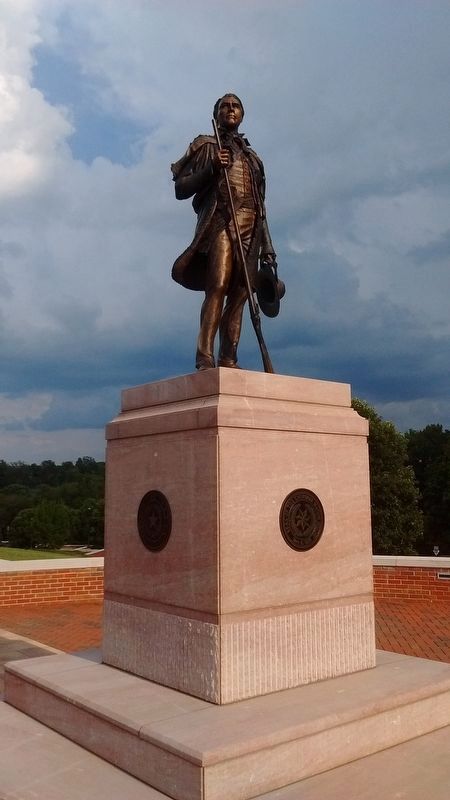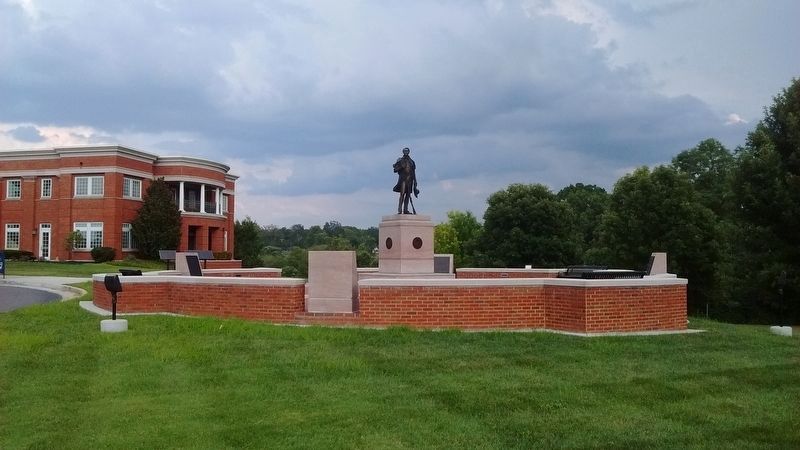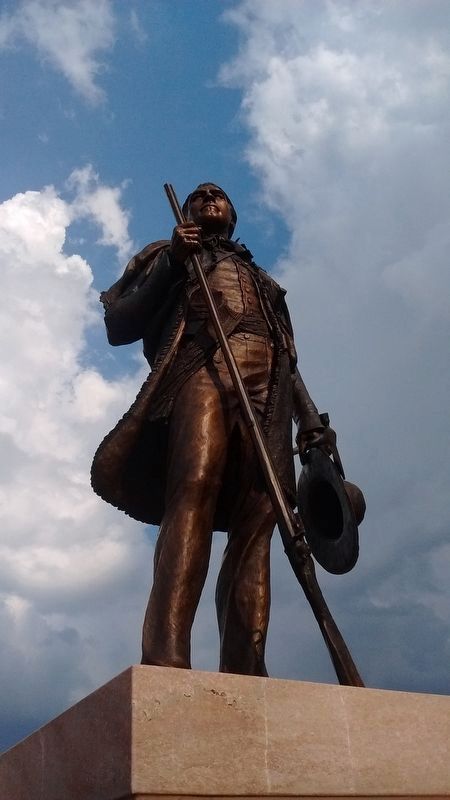Maryville in Blount County, Tennessee — The American South (East South Central)
Sam Houston Statue
Topics. This historical marker is listed in this topic list: Patriots & Patriotism.
Location. 35° 45.081′ N, 83° 58.538′ W. Marker is in Maryville, Tennessee, in Blount County. Marker is at the intersection of West Broadway Avenue (Tennessee Route 411) and West Lamar Alexander Parkway (Tennessee Route 321), on the right when traveling east on West Broadway Avenue. Touch for map. Marker is in this post office area: Maryville TN 37801, United States of America. Touch for directions.
Other nearby markers. At least 8 other markers are within walking distance of this marker. Pride Mansion (within shouting distance of this marker); Relief of Knoxville (within shouting distance of this marker); Montvale Springs (about 400 feet away, measured in a direct line); William Bennett Scott, Sr. (approx. 0.2 miles away); New Providence Church (approx. 0.2 miles away); Maryville Polytechnic School (approx. ľ mile away); The Glascock House (approx. 0.3 miles away); Freedman's Institute (approx. 0.3 miles away). Touch for a list and map of all markers in Maryville.
Also see . . . Sam Houston = Wikipedia. (Submitted on September 6, 2017, by Bill Pfingsten of Bel Air, Maryland.)
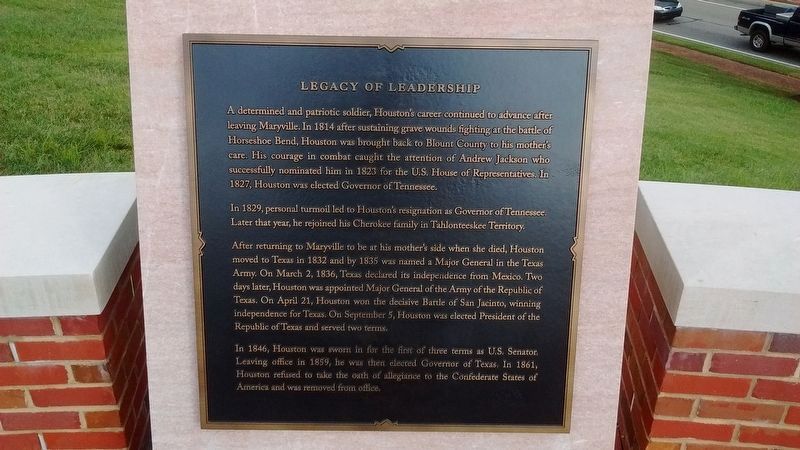
Photographed By Tom Bosse, August 27, 2017
2. Sam Houston Statue - Legacy of Leadership
A determined and patriotic soldier, Houstonís career continued to advance after leaving Maryville. In 1814 after sustaining grave wounds fighting at the Battle of Horseshoe Bend, Houston was brought back to Blount County to his motherís care. His courage in combat caught the attention of Andrew Jackson who successfully nominated him in 1823 for the U.S. House of Representatives. In 1827, Houston was elected Governor of Tennessee.
In 1829, personal turmoil led to Houstonís resignation as Governor of Tennessee. Later that year, he rejoined his Cherokee family in Tahlonteeskee Territory.
After returning to Maryville to be at his motherís side when she died, Houston moved to Texas in 1832 and by 1835 was named a Major General in the Texas Army. On March 2, 1836, Texas declared its independence from Mexico. Tow days later, Houston was appointed Major General of the Army of the Republic of Texas. On April 21, Houston won the decisive Battle of San Jacinto, winning independence for Texas. On September 5, Houston was elected President of the Republic of Texas and served two terms.
In 1846, Houston was sworn in for the first of three terms as U.S. Senator. Leaving office in 1859, he was then elected Governor of Texas. In 1861, Houston refused to take the oath of allegiance to the Confederate States of American and was removed from office.
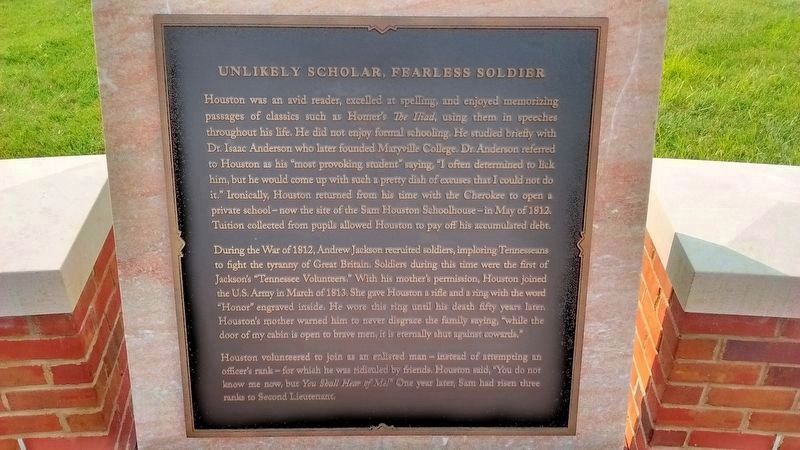
Photographed By Tom Bosse, August 27, 2017
3. Sam Houston Statue - Unlikely Scholar, Fearless Soldier
Houston was an avid reader, excelled at spelling, and enjoyed memorizing passages of classics such as homerís The Iliad, using them in speeches throughout his life. He did not enjoy formal schooling. He studied briefly with Dr. Isaac Anderson who later founded Maryville College. Dr. Anderson referred to Houston as his “most provoking student” saying, “I often determined to lick him, but he would come up with such a pretty dish of excuses that I could not do it.” Ironically, Houston returned from his time with the Cherokee to open a private school – now the site of the Sam Houston Schoolhouse – in May of 1812. Tuition collected from pupils allowed Houston to pay off his accumulated debts.
During the War of 1812, Andrew Jackson recruited soldiers, imploring Tennesseans to fight the tyranny of Great Britain. Soldiers during this time were the first of Jacksonís “Tennessee Volunteers.” With his motherís permission, Houston joined the U.S Army in March of 1813. She gave Houston a rifle and a ring with the word “Honor” engraved inside. He wore this ring until his death fifty years later. Houstonís mother warned him to never disgrace the family saying, “while the door of my cabin is open to brave men, it is eternally shut against cowards.”
Houston volunteered to join as an enlisted man – instead of attempting an officerís rank – for which he was ridiculed by friends Houston said, “You do not know me now, but You Shall Hear of Me!” One year later, Sam had risen three ranks to Second Lieutenant.
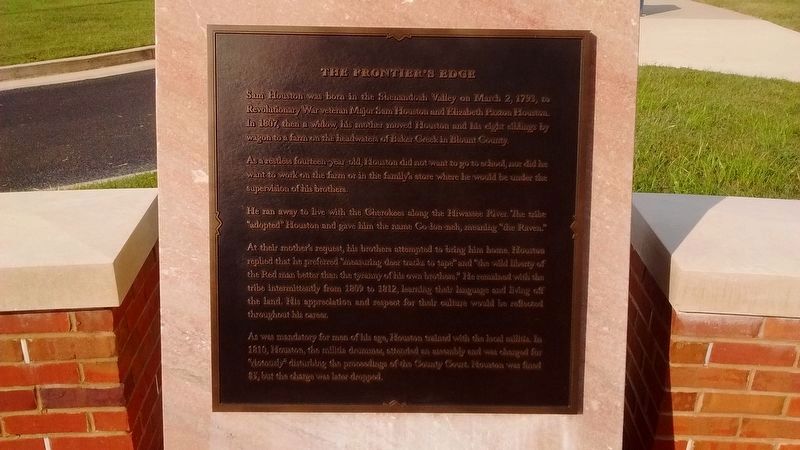
Photographed By Tom Bosse, August 27, 2017
4. Sam Houston Statue - The Frontierís Edge
Sam Houston was born in the Shenandoah Valley on March 2, 1793, to Revolutionary War Veteran Major Sam Houston and Elizabeth Paxton Houston. In 1807, then a widow, his mother moved Houston ad his eight siblings by wagon to a farm at the headwaters of Baker Creek in Blount County.
As a restless fourteen-year-old, Houston did not want to go to school, nor did he want to work on the farm or in the familyís store where he would be under supervision of his brothers.
He ran away to live with the Cherokees along the Hiwassee River. “The tribe “adopted” Houston and gave him the name Co-lon-neh, meaning “the Raven.”
At their motherís request, his brothers attempted to bring him home. Houston replied that he preferred “measuring deer tracks to tape” and “the wild liberty of the Red man better than the tyranny of his own brothers.” He remained with the tribe intermittently from 1809 to 1812, learning their language and living off the land. His appreciation and respect for their culture would be reflected throughout his career.
As was mandatory for men of his age, Houston trained with the local militia. In 1810, Houston, the militia drummer, attended an assembly and was charged for “riotously” disturbing the proceedings of the County Court. Houston was fined $5, but the charge was later dropped.
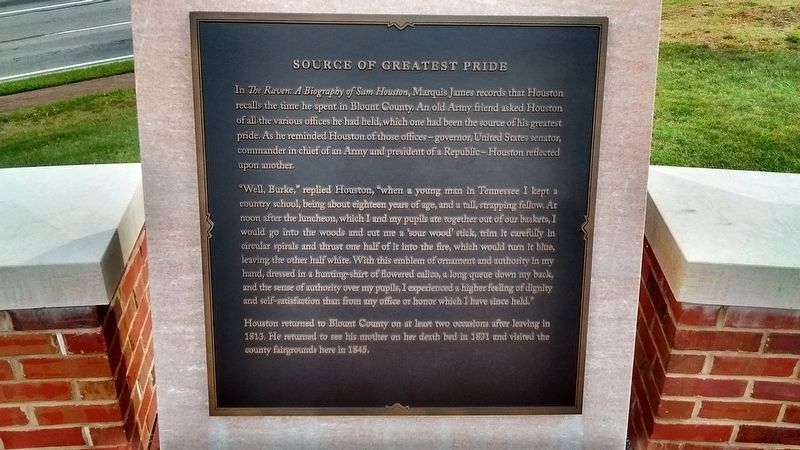
Photographed By Tom Bosse, August 27, 2017
5. Sam Houston Statue - Source of Greatest Pride
In The Raven: A Biography of San Houston, Marquis James records that Houston recalls the time he spent in Blount County. An old Army friend asked Houston of all the various offices he had held, which one had been the source of his greatest pride. As he reminded Houston of those offices – governor, United States senator, commander in chief of an Army and president of a Republic – Houston reflected upon another.
“Well, Burke,” replied Houston, “when a young man in Tennessee I kept a country school, being about eighteen years of age, and a tall strapping fellow. At noon after the luncheon, which I and my pupils ate together out of our baskets, I would go into the woods and cut me a Ďsour woodí stick, trim it carefully in circular spirals and thrust one half of it into the fire, which would turn it blue, leaving the other half white. With this emblem of ornament and authority in my hand, dressed in a hunting shirt of flowered calico, a long queue down my back, and the sense of authority over my pupils, I experienced a higher feeling dignity and self-satisfaction than from any other office or honor which I have since held.”
Houston returned to Blount County on at least two occasions after leaving in 1813. He returned to see his mother on her death bed in 1831 and visited the county fairgrounds here in 1845.
Credits. This page was last revised on September 2, 2020. It was originally submitted on September 4, 2017, by Tom Bosse of Jefferson City, Tennessee. This page has been viewed 634 times since then and 72 times this year. Photos: 1, 2, 3, 4, 5, 6. submitted on September 4, 2017, by Tom Bosse of Jefferson City, Tennessee. 7. submitted on October 24, 2017, by Tom Bosse of Jefferson City, Tennessee. • Bill Pfingsten was the editor who published this page.
